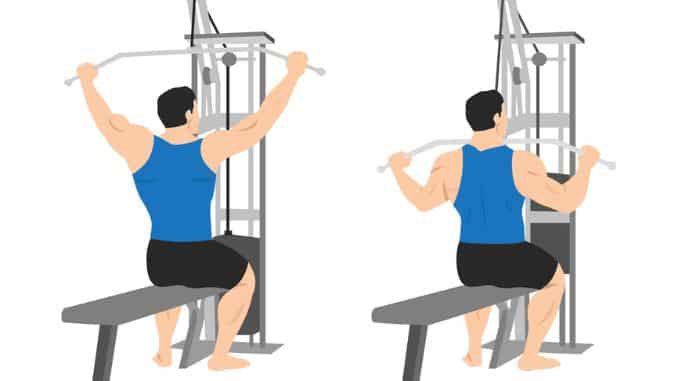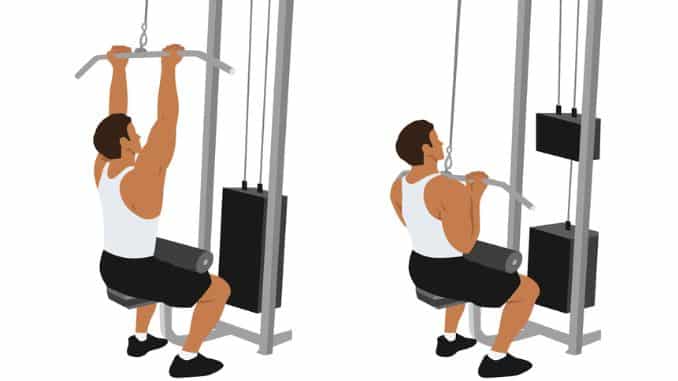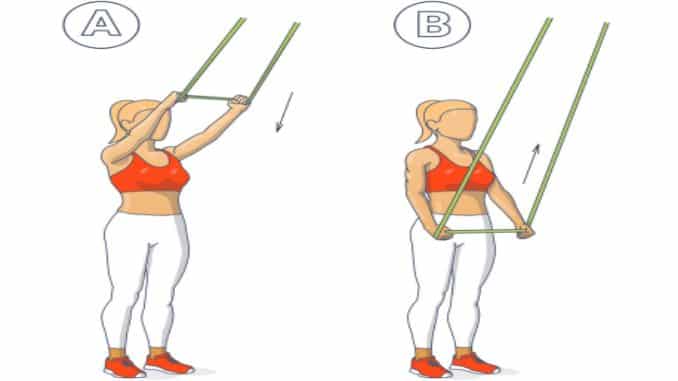A strong back does more than just look good—it supports posture, protects your spine, and powers nearly every upper body movement you make. Whether you’re lifting groceries, carrying your kids, or hitting a personal record at the gym, your back muscles support all of these actions.
The lat pulldown machine is one of the best tools to start building that strength. It’s beginner-friendly, easy to control, and targets the latissimus dorsi—the large, wing-like muscles that shape your upper back. Plus, it helps improve pulling strength, which carries over into everyday life and advanced gym exercises like pull-ups and rows. If you’re looking to improve your back training, incorporating lat pulldown machine back exercises can help optimize your results.
What Is a Lat Pulldown?
Lat pulldown strength has been correlated with performance in activities like swimming and sprinting. These lat pulldown machine back exercises are especially effective when performed with proper grip and technique, providing lasting strength benefits.
You sit at a special machine with a padded seat and a long bar above your head. While keeping your body stable, you pull the bar down toward your chest, then slowly raise it back up. This closely resembles the movement pattern of a pull-up, but instead of lifting your whole body, you’re lifting a set amount of weight. Lat pulldown machine back exercises like this are ideal for beginners and experienced lifters alike.
Why It’s Useful?
- Great for people who can’t yet do a pull-up
- Helps build upper-body strength and muscle endurance
- Strengthens key muscles involved in everyday pulling tasks like opening doors or lifting objects
- Can be adjusted to your strength level by changing the weight
Lat Pulldown

- Begin in a seated position on the lat pulldown machine with your thighs secured under the pads and your feet flat on the floor.
- Reach up and grip the bar with both hands, wider than shoulder-width apart, using an overhand (palms forward) grip.
- Engage your core and keep your chest lifted. Slowly pull the bar down in front of you toward your upper chest, squeezing your shoulder blades together.
- Pause briefly, then slowly return the bar to the starting position with control.
- Breathe deeply in through your nose and out through your mouth. Repeat the movement.
Lat Pulldown Variations
1. Wide-Grip Lat Pulldown

- Sit tall on the lat pulldown machine with your feet flat on the floor and your thighs secured under the pads.
- Reach up and grasp the bar with a wide, overhand grip—your hands should be wider than shoulder-width apart.
- Engage your core and slightly lean back. Pull the bar down smoothly toward your upper chest, keeping your elbows pointed down and back.
- Squeeze your shoulder blades together at the bottom.
- Hold briefly, then slowly return to the starting position.
- Take several deep belly breaths, in through your nose and out through your mouth. Repeat the movement.
– Builds back width and targets the outer lats.
2. Close-Grip Lat Pulldown

- Begin in a seated position on the lat pulldown machine with your feet flat on the floor and your thighs secured under the pads.
- Reach up and grasp the close-grip handle or bar with your palms facing each other, hands positioned closer than shoulder-width apart.
- Engage your core and keep your chest lifted. Slowly pull the handle down toward the top of your chest, keeping your elbows tucked in and close to your sides.
- Squeeze your shoulder blades together at the bottom of the movement.
- Pause briefly, then return the handle to the starting position with control.
- Take several deep belly breaths, in through your nose and out through your mouth. Repeat the movement.
– Uses a V-bar or narrow grip to focus on the mid-back and lower lats.
3. Underhand (Reverse-Grip) Lat Pulldown

- Sit tall on the lat pulldown machine with your feet flat on the floor and your thighs secured under the pads.
- Reach up and grasp the bar with an underhand (palms facing you) grip, with your hands shoulder-width apart.
- Engage your core and keep your chest up.
- Pull the bar down toward your upper chest by bending your elbows and squeezing your shoulder blades together.
- Keep your elbows close to your body throughout the movement.
- Pause briefly at the bottom, then slowly return the bar to the starting position.
- Take several deep belly breaths, in through your nose and out through your mouth. Repeat the movement.
– Easier on the shoulders and increases biceps activation.
4. Resistance Band Lat Pulldown

- Stand tall with your feet shoulder-width apart and a resistance band securely anchored above you.
- Hold the ends of the band with both hands, arms extended overhead at a slight angle.
- Engage your core and maintain a straight posture.
- Pull the band down toward your chest by bending your elbows and squeezing your shoulder blades together.
- Pause briefly at the bottom, then slowly return to the starting position.
- Take several deep belly breaths, in through your nose and out through your mouth. Repeat the movement.
– Great for home workouts; mimics the lat pulldown machine motion while reducing joint load.
5. Straight-Arm Pulldown

- Stand in front of a cable machine with your feet shoulder-width apart and a slight bend in your knees.
- Grasp the straight bar with both hands using an overhand grip, arms fully extended overhead and slightly in front of you.
- Engage your core and keep your back flat. Pull the bar down in a straight line toward your thighs, keeping your arms straight throughout the movement.
- Squeeze your lats at the bottom. Pause briefly, then slowly return to the starting position with control.
- Take several deep belly breaths, in through your nose and out through your mouth. Repeat the movement.
– Focuses directly on the lats with minimal bicep use.
Best Grip for Lats
If your goal is to train your back and build strong lats, the best grip is:
- Overhand (pronated) grip
- Pulled to the front of your chest
- Avoid pulling behind the neck unless you have excellent shoulder mobility, as it increases the risk of shoulder impingement.
Benefits of the Lat Pulldown
- Improves pulling strength, muscular hypertrophy, and endurance.
- Supports athletes in swimming, gymnastics, wrestling, rugby, skiing, and bodybuilding.
- Helps develop strength for upper-body pulling motions essential in sports and functional movement.
- Lat pulldown strength has been correlated with performance in activities like swimming and sprinting.
- Medium grip balances strength, performance, and activation, making it ideal for most trainees.
Muscles Worked
- The lat pulldown exercise primarily targets the latissimus dorsi muscles, as well as the biceps and rear deltoids.
- In addition to the lats, the movement activates supporting muscles like the biceps, rear deltoids, trapezius, and rhomboids.
- Lat pulldowns can help improve posture and reduce the risk of back injuries.
- It’s essential to focus on proper form and technique to ensure effective muscle activation.
Conclusion
Lat pulldown machine back exercises are great for building a stronger back, especially the lat muscles. You can try different versions like close grip, wide grip, and reverse grip to work your back in different ways.
If you are suffering from back discomfort, click here to check out the Low Back Pain Solved program.
FAQ’s
Does a lat pulldown work your back?
Yes! The lat pulldown is a great exercise for your back. It mainly works the big muscles on the sides of your upper back called the lats (short for latissimus dorsi). It also helps strengthen your shoulders and arms.
Which back exercise is performed on the lat pulldown machine?
The back exercise you do on the lat pulldown machine is called the lat pulldown. You sit down, grab the bar above your head, and pull it down toward your chest. This pulling motion helps build strength in your upper back and arms.
What part of the back does a lat pulldown workout target?
The lat pulldown mainly works the upper and outer back, especially the latissimus dorsi muscles. It also works the shoulder blades, biceps, and some of the middle back muscles.


